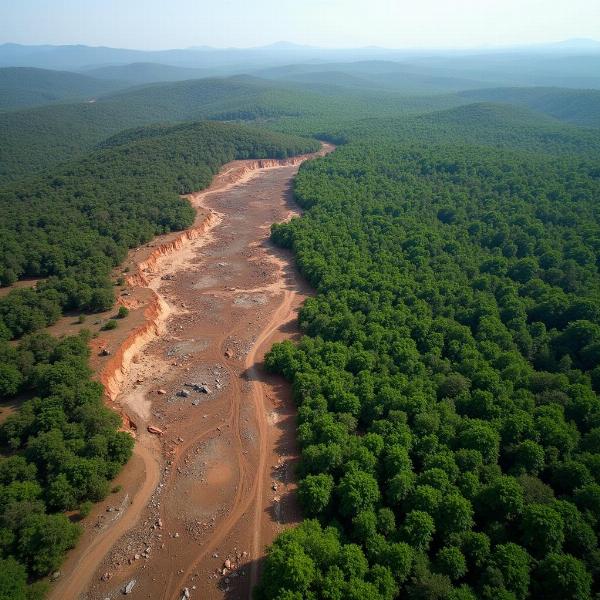Catastrophic depletion, a phrase that carries significant weight, often arises in discussions about environmental issues and resource management. Understanding its meaning in Hindi, along with its implications, is crucial for effective communication and informed decision-making. This article explores the various facets of “catastrophic depletion meaning in Hindi,” providing a comprehensive understanding of the term and its relevance in diverse contexts.
What Does Catastrophic Depletion Mean?
Catastrophic depletion refers to the sudden and severe reduction of a resource, often to the point of near-exhaustion. This rapid decline can have devastating consequences, impacting ecosystems, economies, and human well-being. The term highlights the gravity of the situation, emphasizing the irreversible damage that can occur when resources are exploited unsustainably.
Catastrophic Depletion in Hindi: विनाशकारी ह्रास (Vināśakārī hrās)
The Hindi translation of catastrophic depletion is विनाशकारी ह्रास (Vināśakārī hrās). विनाशकारी (Vināśakārī) means destructive or catastrophic, while ह्रास (hrās) signifies depletion or reduction. Together, they accurately convey the meaning of a severe and damaging decline.
Understanding the Nuances of विनाशकारी ह्रास
While विनाशकारी ह्रास encapsulates the core meaning, different contexts might require more specific translations. For instance, when discussing the depletion of natural resources, one might use प्राकृतिक संसाधनों का विनाशकारी ह्रास (prākritik sansādhanōn kā vināśakārī hrās), which explicitly mentions natural resources. Similarly, when discussing the depletion of the ozone layer, ओजोन परत का विनाशकारी ह्रास (ōjōn parat kā vināśakārī hrās) would be more appropriate.
The Causes of Catastrophic Depletion
Several factors contribute to catastrophic depletion. Overexploitation, driven by increasing demand and unsustainable practices, is a primary driver. Natural disasters, climate change, and pollution can also exacerbate the decline of resources.
The Impact of Catastrophic Depletion
The consequences of catastrophic depletion can be far-reaching and devastating. Loss of biodiversity, economic instability, food shortages, and displacement of communities are some of the potential impacts. Understanding these consequences is critical for promoting sustainable resource management and mitigating the risks associated with depletion.
 Deforestation and its Impact
Deforestation and its Impact
What Can Be Done to Prevent Catastrophic Depletion?
Addressing catastrophic depletion requires a multi-pronged approach. Implementing sustainable practices, promoting responsible consumption, investing in research and development, and strengthening environmental regulations are crucial steps. Raising awareness about the issue and fostering international cooperation are also essential for achieving long-term solutions.
Catastrophic Depletion: A Global Concern
Catastrophic depletion is not limited to a specific region or resource. It is a global challenge that demands collective action. By working together, we can protect our planet’s resources and ensure a sustainable future for all.
Dr. Priya Sharma, an environmental scientist based in Delhi, emphasizes the importance of community involvement in resource management. She states, “Local communities play a vital role in protecting natural resources. Their knowledge and participation are crucial for implementing effective conservation strategies.”
Conclusion
Catastrophic depletion, or विनाशकारी ह्रास, is a serious issue with far-reaching consequences. Understanding its meaning in Hindi and its implications is vital for addressing this global challenge. By promoting sustainable practices and fostering responsible resource management, we can mitigate the risks associated with catastrophic depletion and ensure a sustainable future.
FAQ
- What is the literal translation of catastrophic depletion in Hindi? The literal translation is विनाशकारी ह्रास (Vināśakārī hrās).
- What are the main causes of catastrophic depletion? Overexploitation, natural disasters, climate change, and pollution are key drivers.
- How does catastrophic depletion affect communities? It can lead to economic instability, food shortages, and displacement.
- What can individuals do to prevent catastrophic depletion? Practice responsible consumption and support sustainable initiatives.
- Why is understanding catastrophic depletion important? It helps in promoting sustainable resource management and mitigating environmental risks.
- Is catastrophic depletion a global issue? Yes, it affects resources and communities worldwide.
- What are some examples of catastrophic depletion? Depletion of groundwater, deforestation, and overfishing are examples.
Meaning-Hindi.in offers expert translation services in various domains, including business, legal, technical, website localization, educational, and specialized fields. We are committed to providing accurate and culturally sensitive translations that bridge language barriers and facilitate effective communication. Need help translating documents related to environmental sustainability or any other subject? Contact us today for a free quote! Email: [email protected], Phone: +91 11-4502-7584. Meaning-Hindi.in is your trusted partner for all your Hindi translation needs.